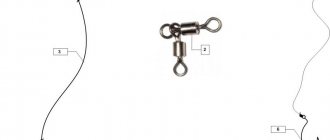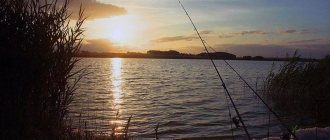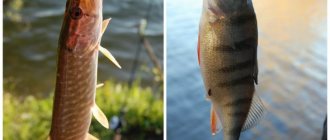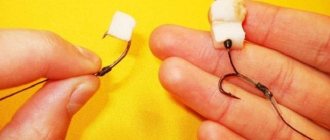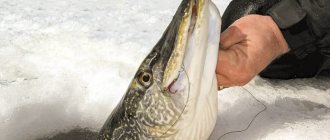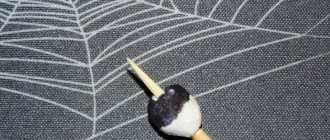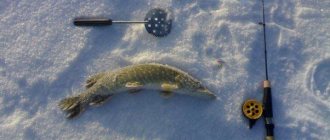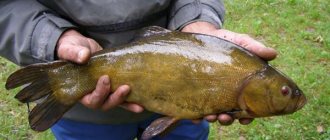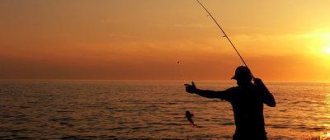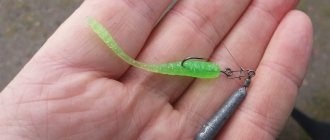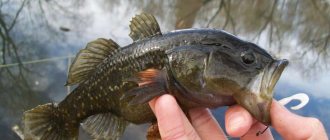With the development of new technologies, more and more new methods of fishing are being introduced into the art of fishing. One of these innovations was fishing with a retractable leash, which immediately established itself well among a wide range of fishing enthusiasts. Here you will learn how to properly install a diverter leash for pike perch, perch, pike, bream, roach, and you can also watch a video.
What kind of gear is this?
A retractable leash is, first of all, a universal tackle for catching predatory fish such as perch, pike perch and pike; however, retractable leashes are also good for catching catfish, roach, bream, burbot and some types of white fish that live in the bottom layers of water.
This universal tackle consists of a triple or double swivel, depending on the type of fishing, donk, spinning or float tackle, a weight, a piece of fishing line of various lengths and a hook with bait.
On spinning tackle, it is best to use a retractable leash with a jig head or spoon at the end, where it will be attached to the main line using a double swivel. This is done for two reasons, namely:
- If you have one leash, the likelihood of the bait getting tangled is zero, because the presence of a swivel prevents the leash from getting tangled or twisted.
- If you have a leash, which includes copper wire or braided fishing line, a predatory fish will not be able to bite the main fishing line and break away.
On float or bottom rigs, diverting leashes with double swivels are used, at the ends of which a sinker is attached on one side, and on the other, a well-pointed hook with bait. The third part of the swivel is attached to the central fishing line.
On bottom rigs, the presence of a diverting leash plays a very important role. Firstly , if there is a current on the water, you can hang an additional weight at the end of the leash, where the sinker is located, or replace the sinker with a heavier piece, which in turn improves the casting range of the tackle and prevents the bait from dragging along the bottom downstream.
Secondly , a cautious fish, such as bream or roach, will not see foreign objects, such as a sinker, next to the bait and, due to the current, which will play with the bait located at the end of the outlet leash, will grab the bait and get hooked.
As for the float tackle , the diverting leash plays a distracting role from the main tackle and, just as in the case of bottom tackle, if there is a current in the water, the bait will develop in the water, imitating a live snack for an unsuspecting fish.
Installation of a branch leash
There are several types of installation of diverter leashes that are suitable for fishing for various fish, both with feeder or bottom equipment, and with spinning equipment. Also, depending on the time of year, different types of installation are used for flowing or standing water. Installation options are as follows:
- Blind installation (winter).
- Sliding installation.
- Spinning type of installation.
Solid installation
The blind rig is used in the winter season in still water and is intended for catching both perch, asp, pike and pike-perch, provided that the fishing will take place with the setting of a pole, as well as bream, white bream and other types of fish with a regular winter fishing rod.
For the blind installation of a branch leash you will need: a swivel, double or triple, which will be attached to the main fishing line using knots, a piece of fishing line 20-30 centimeters long, a hook, a sinker.
- A triple swivel is attached to the end of the main line using a loop knot and pulled tight.
- A prepared piece of fishing line with a hook at the end is attached to the other end of the swivel. Depending on the type and size of the fish, the hook is also selected according to the appropriate number.
- A weight is attached to the third end of the swivel, on a line of shorter length than the line of the diverter leash, to prevent the pieces of line from tangling.
- You can also use a blind mount on a correction rod, but with an appropriate weight.
Sliding installation
Sliding installation differs from blind installation in that the load slides along the main fishing line and the leash can freely go downstream until the main fishing line is tensioned.
This type of installation is more common from spring to autumn, on rivers with a current, but it can also be used in standing water even in winter. With this method of mounting the gear, bites will be the most sensitive, and all vibrations from the bait will be transmitted to the main line. For a sliding type of installation for a retractable leash, you will need two double swivels, two pieces of fishing line, one 15 centimeters and the other 20-25 centimeters, a weight, a hook and a stopper so that the swivels do not get tangled.
- A double swivel is threaded onto the main line, where a stopper is tied at its end so that the swivel rests against the stopper when sliding freely.
- 15 is attached to one end of the swivel . In this position, the load remains at the bottom, and the main line can freely develop with the flow.
- A second double swivel with a piece of fishing line 20-25 centimeters long and a hook at the end is attached to the other end of the stopper.
As for spinning rods , such installations are not suitable, because when retrieving, the sinker will catch on underwater rocks or vegetation and create the illusion of a bite. In this case, a spinning leash installation is used.
The spinning rig for a diverting leash is the simplest and most effective for catching predators. For it you will need a double swivel, a piece of strong fishing line, preferably braided, and the bait itself, which will be used to catch predatory fish.
- A swivel is attached to the end of the central fishing line using a good knot.
- A piece of fishing line with a loop for putting on the bait and the bait itself are attached to the swivel.
Due to the heaviness of the bait, a weight is not placed in this setup, since the bait is used at different depths.
Sliding equipment
Winter fishing rods with a side leash in a sliding version allow you to quickly fish different fishing horizons by simply moving the attachment point higher or lower on the main line. This method of fastening is made using a ring or bead placed on the main fishing line, limited by rubber or knot stoppers. A running outlet is often used in fishing rods and winter fishing rods.
Through the stopper
Moscow equipment
In heavy winter donkeys (downhill, helicopter), as well as when catching predators, another sliding rig is more often used. In such a rig, the sinker on the outlet is attached to the main line with a swivel. In essence, it turns out to be a side leash with a sinker. The working leash is a continuation of the main line, which passes through the loop of the swivel of the cargo outlet. The movement of the sinker along the fishing line is also limited by stoppers or beads. It turns out to be a universal tackle, on which you can change the length of the leash at any time.
Descent
Leash for zander
Pike perch are caught exclusively using spinning gear and trolling. To catch it, bait is used in the form of lures made of silicone, spinners, and deep wobblers, since pike perch prefers to live in the bottom layers of the aquatic environment. The leash for spinning fishing for pike perch must be strong and made of braided fishing line or thin copper wire, which the pointed teeth of a predator cannot bite through.
Also, a copper wire leash prevents the main line from catching on the pike perch’s dorsal fin, which is very sharp and can easily cut any line except braided line. Also, when making a leash for catching pike perch, it is worth taking into account the integrity of the swivel, which can break due to wear and a long stay in the water.
Leash for perch
Perch is much smaller in size than pike perch and leashes for catching it can be made from monofilament fishing line, which has a transparent color and is less noticeable in the water column. As bait for perch, small spoons and wobblers are attached to the end of the leash. In order to cast further when catching this type of predator, it is worth using the main line of a braided type, since it is lighter than monofilament. When fishing for perch with a jig head in snags or a grassy bottom of a reservoir, it is better to make leashes from braided fishing line so as not to break the bait, which is very expensive.
- Sinker weighing 10-30 grams.
- Leash length 50-120 cm.
- Length to load 15-30 cm.
Pike leash
To catch pike with this type of leash, leashes made of durable material, such as copper wire, are used, since the predator, like pike perch, has pointed teeth that can easily bite through a leash made from ordinary fishing line. In the winter season, when fishing for pike on girders, it is better to take a thick monofilament line as the central line and a copper wire leash, since the bait in this case is active live bait, which, with the lightness of the main line and the outlet leash, can make a false bite.
- Monofilament for leash 0.2;
- Main line 0.25;
- Sinker from 20 grams, depending on the current. On a strong one, it makes sense to use weights of 50 grams or more.
- The length of the leash to the wobbler is 40-150 cm.
Winter diverter leash
A winter leash is used both for fishing with garlands and with fast-action winter fishing rods, but most often a winter retractable leash is used when fishing with bottom tackle with a float.
Applies to:
- Bream;
- Roach;
- crucian carp;
- Perch.
Often, when bottom fishing in winter, a feeder is used, this is especially effective when catching roach and bream.
Tackle diagram:
This retractable leash can be used in combination with a feeder. Such bottom tackle precisely feeds the fish, luring it, and the tackle itself is sensitive when biting.
The main line is taken with a thickness of 0.15. For large fish, a fishing line of 0.18 mm is used. The leash itself is made from monofilament fishing line, slightly narrower than the main one.
Sinkers for small species without current - from 5 grams. For medium without flow from 10 grams. For large ones over 30 grams.
Installation of a winter diversion leash according to Salapin, video:
How to make a lead leash
The simplest option is knitted on the main line:
- a fastener is tied to the end of the fishing line, and a sinker is attached to it;
- a surgical loop is knitted 20-25 cm above the sinker;
- a hook is tied to a piece of fluorocarbon, and a loop is made at the other end;
- A leash is tied to the surgical loop (using the loop-to-loop method).
The disadvantages of this installation are that when hooked, the entire tackle breaks, and not just the leash itself. In addition, frequent tangling of equipment reduces the fishing speed and creates a lot of inconvenience for the fisherman.
If you attach a swivel to the junction of the leash, this will reduce the number of overlaps, but you will not be able to completely get rid of them.
A classic retractable leash for a winter fishing rod is knitted from two pieces of fishing line, one monofilament 20-30 cm, the second fluorocarbon – 50-150 cm (the leash itself).
Installation procedure:
- a weight is attached to a piece of monofilament fishing line; on the other hand, a triple swivel;
- A leash with a hook is knitted from fluorocarbon, with a loop at the free end;
- a fluorocarbon leash is tied to the side arm of the swivel (loop to loop);
- the base is fastened to the free (upper) ring of the tee using a clasp.
To improve the equipment, a fastener is tied to the lower end of the monofilament line, and a weight is attached to it. This is convenient for quickly changing loads, especially during winter fishing, when your hands get cold in the cold.
The breaking load of fluorocarbon should be less than that of monofilament, so that in case of snags, only the leader comes off, and not the entire equipment.
Typically, anglers make several retractable leashes for winter fishing rods at home and wind them on a reel.
The reels are stored in a fishing box, and if necessary, the process of replacing the tackle takes a minimum of time.
Not every angler has a triple swivel necessary for mounting the gear. In this case, the problem of how to tie a lead leash on a winter fishing rod is solved with the help of two ordinary swivels.
In this case, you need two pieces of monofilament fishing line with a diameter of 0.24-028mm and a length of 15-20mm.
Installation procedure:
- A leash with a hook is knitted from fluorocarbon, and a swivel is tied to the free end;
- a fastener is attached to the first piece of monofilament fishing line to attach the sinker, and a swivel is tied to the free end;
- the second piece of monofilament is tied to the free ring of the swivel;
- The swivel of the fluorocarbon leader is put on the second piece of monofilament, and a ring or swivel is tied to its end to connect to the base.
The result is an installation where the swivel of the fluorocarbon leader moves freely along the monofilament base. Overlapping and twisting are excluded with this installation, because the swivels provide free movement. Yes, you have to use extra elements of equipment, but it turns out to be more functional and catchy.
In the event of snags and breaks, replacing the leashes takes just a couple of minutes and the angler does not lose extra time while fishing.
How to tie a leash to the main line
Our rating of knots, including for the leash. How to tie a leash to the main line? As easy as pie:
- The main unit for attaching the diverter leash is considered to be an improved clinch (Fig. below) , which reaches 97% . It is knitted by threading the main line into the ring of a swivel and winding several turns around it, followed by tightening the end of the line.
- Also very common, especially among novice fishermen, is the usual double knot , which is most recommended to do if the main fishing line is braid, since it is softer than monofilament fishing line and will not slip or come undone.
- The bayonet knot is a knot that has some similarities to the improved clinch, the only difference is that with each skein a knot is made around the main line.
- And the best and easiest to use when tying diverter leashes is the figure eight , which, with simple manipulations with the main fishing line around the swivel, forms a connection similar to the number eight. This knot is 95 percent effective and is suitable for all types of fishing line.
Common clinch
Clew Double knot Figure eight knot
Methods for attaching a leash
There are several options for attaching the leash to the equipment. For example:
- Using the “loop-to-loop” method. A loop is formed at the end of the leash, which is threaded through the loop on the main fishing line, after which a hook is threaded into the same loop. Finally, the connection is tightened. The disadvantage of this option is the fact that it is impossible to quickly change the leash. Despite this, there are no problems with removing the leash.
- Attaching the leash using a swivel. This method allows you to minimize overlaps.
- Fastening the leash using a clasp (carabiner). This is the most progressive option, allowing you to easily change the leash to a new one, since very often you have to experiment.
Fishing technique with a retractable leash
When fishing with a retractable leash, there are several important rules. Namely:
- When fishing with bottom tackle, it is important that the line is in a taut position, so that when a fish bites, the reaction of the bite at the tip of the rod is instantaneous.
- When casting, you need to make sure that the retractable leash and the leash with the sinker are not mixed up, otherwise the bait will not be effective in the current in the water, or even in flight it may be knocked off the hook by the sinker.
- When using the bottom fishing method, in some cases a method called dotted feeding is used, when after casting and after a certain period of time, usually 2-3 minutes, the bait is pulled 20-30 centimeters from its original location. This method is used to prevent the bait from caking on the bottom and raising a small cloud of turbidity that attracts fish.
- When fishing with a spinning rod, they use their own methods of fishing with a retractable leash, which include slow and fast retrieves along the bottom, retrieves with sharp jerks and waiting pauses between them, aggressive retrieves, which include several approaches with jerks and pauses.
An extremely important role in fishing with a diverting leash is assigned to sinkers , which must be selected depending on the strength of the current , depth and bottom topography . For example, when fishing for bream at great depths and with a sandy bottom, long and bullet type sinkers are used. And in snagy terrain and in some spinning rigs with a lead lead, sinkers such as a Tyrolean stick and a drop shop are used.
In winter (late autumn), when fishing on the current, it is best to use a blind leash rig so that the main line does not touch the ice cover and does not rub against it, however, in winter the fish are more careful and it is more difficult to notice a bite, and professional fishermen prefer a sliding rig so that they can catch fish in time. notice the slightest touch of the fish to the bait.
Also, when fishing for fish, you need to take into account that after biting you do not need to make a sharp jerk with the rod, because the mass of the fish and sinker can break the main line or break the rod. It is best to make a small hook so that the fish sits securely on the hook and, using gradual wave pulls and winding the fishing line onto the clutch of the reel, pull the fish to the shore or into the landing net.
Retractable leash for winter fishing rod installation - equipment
There are different ways to install equipment and each fisherman has his own opinion on this matter. But to avoid disappointments while fishing, you need to understand the mechanics of moving the bait in the water column and know how to tie the lead leash to the main line so that there are no overlaps or twists.
The equipment consists of:
- weight;
- hook;
- swivel;
- a piece of fishing line;
- bait.
The shape of the weight is chosen depending on the fishing conditions. For a cluttered, snagged bottom, you need a maneuverable load - a Tyrolean stick or a sinker in the form of a bar. This shape reduces snags and allows you to fish large areas without fear of breaking the tackle.
For fishing on a clean bottom, choose pear-shaped or drop-shaped weights that have less permeability but greater sensitivity. When tapping the bottom with a drop-shaped sinker, the angler receives information about the relief and “slows down the retrieve” in promising places, above holes or edges.
The weight of the cargo is selected depending on:
- current forces;
- depth at the fishing point;
- distances to the coastline;
- fish activity.
A light weight for a diverter leash, weighing up to 10 grams, is used for fishing in low currents and shallow depths. It sinks slowly into the water and is inconvenient for deep areas.
At a depth of more than one and a half meters and a strong current, they are caught with loads of 20-30 grams or more. Such weights quickly reach the bottom, and with them the fisherman fishes the entire area under the hole.
Expert opinion
Vladimir Poltoranin
Fisherman - expert
With a heavy load, the equipment loses sensitivity, so you need to choose the optimal weight that matches the fishing conditions.
A hook is an element of tackle that is in direct contact with the fish and it must be:
- sharp;
- unnoticeable;
- durable.
At the same time, the hook size is selected for certain baits, because for example, silicone requires a large offset hook.
Japanese companies Vanfook and Decoy are leading manufacturers of hooks suitable for mounting equipment with a retractable leash.
The hooks are attached tightly to the fishing line with a Palomar knot, or a sliding installation is used with the so-called “wobbler knot” - a loop. Freedom of the bait is needed for pike perch fishing or when fishing for pike, but for bass hunting they use a rigid rig.
Experienced fishermen believe that the diverter leash should be mounted with a triple swivel, which ensures rotation of all elements. Durable and movable small tees guarantee reliability and additional sensitivity of the equipment.
If the fisherman does not have a triple swivel in his box, he uses a double swivel during installation, or ties the leash directly to the base, but this reduces the sensitivity, and therefore the catchability of the tackle.
Choosing a fishing line for a diverting leash is one of the most important stages, because it must be:
- unnoticeable;
- durable;
- low-stretch;
- abrasion-resistant.
Thin lines are less noticeable in the water, but their strength is questionable, especially when fishing for pike perch or pike. Even a high-quality fishing line with a diameter of 0.18 mm is not enough to bring a qualifying trophy out of the hole. Therefore, fishing lines with a diameter of 0.2-0.22mm are the best choice.
The material of the fishing line also plays a big role and monofilament materials are being replaced by fluorocarbon fishing lines, inconspicuous, with high abrasion resistance.
At first, fluorocarbon line was not very strong, and anglers had to use larger diameters. Now there are a lot of high-quality and thin fluorocarbon fishing line on store shelves and there are no problems with the choice.
Fluorocarbon has also proven its advantages when fishing for pike, because its sharp teeth, which easily tear off the monofilament, cannot withstand fluorocarbon materials.
The length is selected depending on the activity of the fish; the less activity of the predator, the longer the leash. Standard length is 0.6-1.5 meters.
The list of baits for fishing with a retractable leash is large, these are:
- silicone fish;
- vibrators;
- turntables;
- surface wobblers;
- swimbaits;
- polyurethane and foam fish.
It is clear that the choice of bait depends on the size and variety of the intended trophy, but the depth at the point and the strength of the current are also taken into account. The bait is also selected according to the size of the hook on the rig.
